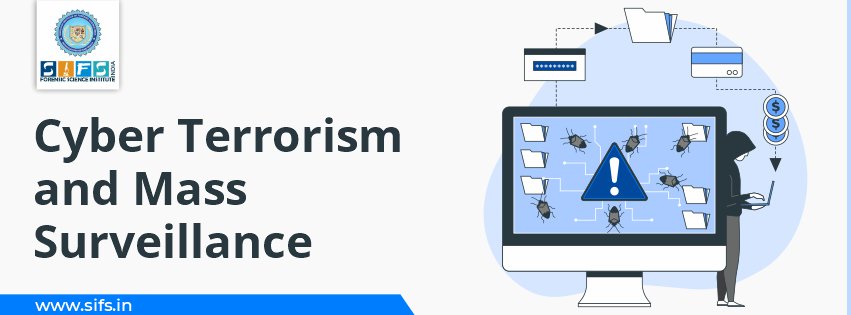- Call Us: +91 7303913002
- Email Us: education@sifs.in
Cyber Terrorism and Mass Surveillance

BY SIFS India | January 13, 2025
Cyber Terrorism and Mass Surveillance
If we see the statics, India ranks second in the World for the no. of internet users, with 455 million users connected according to the Internet world stats.
The majority of Internet Users are found in urban areas. Increased dependency of people on the Internet put them at greater risk of becoming Victims of Cyber crime.
Cyber crime is a Crime committed in cyberspace which is carried out by the means of computers on the Internet. In Cyberspace people from distance can communicate with each other but the same platform may also be used by cyber-terrorists.
Cyber Terrorism
Cyber Terrorism is the convergence of cyberspace with terrorism. It is the use of the Internet to conduct violent attacks and threats in order to achieve political, social and ideological gains to cause severe disruption or widespread fear in the society.
According to the US Federal Bureau of Investigation, It is a premeditated politically motivated attack against the information computer systems, computer programs & data which results in violence against noncombatant targets by sub-national groups on clandestine agents.
In India, Section 66F of the Information technology Act 2000 defines cyber terrorism & prescribes the punishment for this act. This section has been introduced after the 26/11 Mumbai attacks.
The Virtual space attracts modern terrorists as it is relatively easy, and cheaper and the identity of an attacker is anonymous & untraceable. Cyberspace is now becoming a meeting point for criminals.
Many people are becoming aware of possible cyberspace violations but there are several no. of peoples who are unaware of it.
India saw a significant jump in cybercrimes reported in 2020 from the previous year.
That year, over 50 thousand cybercrime incidents were registered. Karnataka and Uttar Pradesh accounted for the highest share during the measured time period.
Uttar Pradesh leads the way as the northern state of Uttar Pradesh had the highest number of cybercrimes compared to the rest of the country, with over six thousand cases registered with the authorities in 2018 alone. India’s tech state, Karnataka, followed suit that year.
A majority of these cases were registered under the IT Act with the motive to defraud or sexually exploit victims.
It has now become a numbers game, It was estimated that in 2017, consumers in India collectively lost over 18 billion U.S. dollars due to cybercrimes.
However, these were estimates based only on reported numbers. In a country like India, it is highly likely that the actual figures could be under-reported due to a lack of cybercrime awareness or the mechanisms to classify them.
Recent government initiatives such as a dedicated online portal to report cybercrimes could very well be the main factor behind a sudden spike in online crimes from 2017 onwards. Number of cyber crimes reported across India in 2020, by leading state.
Mass Surveillance
According to the 2019 Forrester Global Map of Privacy Rights and Regulations, India is among the list of countries where government surveillance is the lowest. There are some mass surveillance projects by the Indian government listed below:
1. Forrester Global Map of Privacy Rights and Regulations: Developed by the Centre for Artificial Intelligence and Robotics (CAIR) of the Defence Research and Development Organisation. NETRA has the capability to intercept and analyse data (including voice traffic) passing through Google, Skype, and other social networking forums. It can also track keywords from emails, tweets, Facebook status updates, comments, blogs, messages on forums, and even images shared over the Internet.
2. Central Monitoring System (CMS): The CMS is the country's ace surveillance project which aims to create a system that provides central and direct access to information without any intervention by third parties. Developed by the Centre for Development of Telematics (C-DOT), the CMS is capable of accessing all communication data (telephone calls, mobile and landline, VolP calls, emails, and other communication on social media).
3. National Intelligence Grid (NATGRID): In view of the increasing number of terrorist activities in the country, NATGRID was proposed just after the 26/11 Mumbai attacks. The grid provides intelligence agencies access to data sources, including bank accounts, details regarding taxes, credit card transactions, vehicle registration, and immigration and visa records among others, which are then used to decipher patterns and track suspicious activities. However, the program allegedly remains semi-functional.
4. Lawful Interception and Monitoring Project (LIM): The LIM works in a similar way to NETRA. It is a program for surveillance of Internet traffic in India, allowing the monitoring of all traffic (text and audio) passing through ISPs. The LIM's unique capability is to conduct automated keyword searches, which allows government agencies to track data passing through servers for as long as they want, without the ISP's knowledge.
Despite adopting various security and defence mechanism the threat of cyber terrorism continues to increase due to the constant development of internet-based platforms.
As an internet user, one must be careful and take necessary precautions so that he/she does not fall prey to such cyber crime.
Mass Surveillance is the Intricate surveillance of an entire or a substantial fraction of a population in order to monitor that group of citizens.
This surveillance is carried out by local & federal governments or government organizations like NSA & FBI.
The complete radiation of cyber crime is a far-fetched dream but adequate precautionary measures can be taken to curb the growth of cyber crime. Online Surveillance is one such method to combat Cyber terrorism.
Written by: Khushi Kumari

